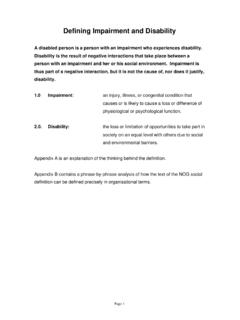Transcription of Small and Medium-sized Enterprises: Local Strength, Global ...
1 Policy BriefOrganisation for Economic Co-operation and Development OECD 2000 June 2000 SummarySmall and Medium-sized enterprises (SMEs) account for over 95% of firmsand 60%-70% of employment and generate a large share of new jobs in OECD economies. They have specific strengths and weaknesses that may require spe-cial policy responses. As new technologies and globalisation reduce theimportance of economies of scale in many activities, the potential contribu-tion of smaller firms is enhanced. However, many of the traditional problemsfacing SMEs lack of financing, difficulties in exploiting technology, con-strained managerial capabilities, low productivity, regulatory burdens become more acute in a globalised, technology-driven firms need to upgrade their management skills, their capacity to gatherinformation and their technology base.
2 Governments need to improve SMEaccess to financing, information infrastructures and international regulatory, legal and financial frameworks conducive to entrepre-neurship and Small firm start-up and growth is a public-private partnerships and Small -firm networks and clustersmay be the most expeditious path to a dynamic SME sector. Grouped in localsystems of production, SMEs can often be more flexible and responsive to cus-tomer needs than large integrated firms. They can pool resources and sharethe costs of training, research and marketing. Clustering facilitates exchangeof personnel and diffusion of technology and creates new possibilities for effi-ciency gains. Importantly, these Local networks and support systems can helpSMEs meet the challenges of globalisation.
3 Whether alone or in clusters, SMEsare seeking international opportunities through strategic alliances, franchisingand joint policy initiatives should take account of regional and Local fac-tors which affect entrepreneurship and build on these particularities to fostersmall-firm partnerships. Policies should use Local institutions, groups ofindustries and inter-firm linkages to create and strengthen the micro-levelbonds which can underpin Global competitiveness. Building on localstrengths, SME policies need to address the new dynamics of entrepreneur-ship and Small -firm clusters to meet the challenges posed by are SMEs?What is their economiccontribution?In which sectors areSMEs found?Why is entrepreneurshipimportant?How innovative aresmaller firms?What type of SMEfinancing is needed?
4 Are SMEs active in globalmarkets?Will SMEs be a factor inelectronic commerce?How can SMEs contributeto sustainabledevelopment?What shouldgovernments do?What is the role of theOECD?For further readingWhere to contact usSmall and Medium-sized Enterprises: Local Strength, Global Reach2 Policy BriefSmall and Medium-sized Enterprises: Local Strength, Global ReachWhat are SMEs?SMEs are defined as non-subsidiary,independent firms which employfewer than a given number ofemployees. This number variesacross national statistical most frequent upper limit is 250employees, as in the EuropeanUnion. However, some countries setthe limit at 200 employees, while theUnited States considers SMEs toinclude firms with fewer than 500employees. Small firms are generallythose with fewer than 50 employees,while micro-enterprises have at mostten, or in some cases five, assets are also used todefine SMEs.
5 In the EuropeanUnion, SMEs must have an annualturnover of EUR 40 million or lessand/or a balance-sheet valuation notexceeding EUR 27 is their economic contribution?SMEs play a major role in economicgrowth in the OECD area, providingthe source for most new jobs. Over95% of OECD enterprises are SMEs,which account for 60%-70% ofemployment in most countries. Aslarger firms downsize and outsourcemore functions, the weight of SMEsin the economy is increasing. Inaddition, productivity growth andconsequently economic growth isstrongly influenced by the competi-tion inherent in the birth and death,entry and exit of smaller firms. Thisprocess involves high job turnoverrates and churning in labour mar-kets which is an important part ofthe competitive process and struc-tural change.
6 Less than one-half ofsmall start-ups survive for morethan five years, and only a fractiondevelop into the core group of high-performance firms which driveindustrial innovation and perform-ance. This underscores the need forgovernments to reform policies andframework conditions that have abearing on firm creation and expan-sion, with a view to optimising thecontributions that these firms canmake to which sectors are SMEs found?Most SME jobs are in the service sec-tor, which now accounts for two-thirds of economic activity andemployment in OECD firms are found particularlyin wholesale and retail trade, thehotel and restaurant business, com-Share of SMEs in business firmsSource: Joint OECD/Eurostat database on SME European Union: percentage shareof enterprises by size classB.
7 United States: percentage shareof enterprises by firm size (total economy ) < > > 5004%0-950%10-9938%Share of SMEs in business firmsSource: Joint OECD/Eurostat database on SME European Union: percentage shareof enterprises by size classB. United States: percentage shareof enterprises by firm size (total economy ) < > > 5004%0-950%10-9938%Share of SMEs in business firmsSource: Joint OECD/Eurostat database on SME European Union: percentage shareof enterprises by size classB. United States: percentage shareof enterprises by firm size (total economy ) < > > 5004%0-950%10-9938%3 Policy BriefSmall and Medium-sized Enterprises: Local Strength, Global Reachmunications and business services,and construction. SMEs also accountfor a high percentage of manufactur-ing firms in many OECD countriesand provide at least half of OECD manufacturing employment.
8 Smallerfirms are increasingly present intechnology-intensive industriessuch as information and communi-cations technology (ICT) and predominate in the importantstrategic business services subsector,including services relating to com-puter software and informationprocessing, research and develop-ment, marketing, business organisa-tion and human resourcedevelopment. Increased outsourcingby major manufacturing firms, com-bined with new technologies thathave allowed SMEs to win marketniches, has led to 10% annualgrowth in these knowledge-basedservices in recent years. The fact thatthe average firm size in strategicbusiness services is a fraction of theaverage size of firms in manufactur-ing or in the economy as a whole isan indication of the importance ofSMEs in this is entrepreneurship important?
9 A vibrant entrepreneurial sector isessential to Small -firm are people who senseopportunities, innovate, take risksand develop new goods and drive business dynamics thebirth, expansion, contraction anddeath of firms and fuel overall eco-nomic growth. The entrepreneurialprocess, however, remains mysteri-ous. Social, cultural and political fac-tors in countries influence theavailability of entrepreneurial oppor-tunities as well as the degree of risk-taking and the mobility of discouraging entrepreneur-ship include education and trainingwhich is risk-averse and regulationsand institutional impediments whichdiscourage the establishment of newventures or expansion of tends to varyacross regions. Some regions orlocales are known for generatingclusters of dynamic firms which ben-efit from information spillovers andother intangible factors.
10 All countrieshave Local pockets with extremelyhigh levels of entrepreneurial activity, Silicon Valley in the UnitedStates, Arezzo and Modena in Italy,Valencia in Spain, N remberg inGermany, and Gnosj in , social and intellectual capi-tal and Local networking influencethe development of such firm can be of particular bene-fit to smaller firms which, because oftheir size, cannot finance in-houseservices such as training, research ormarketing. And clustering can gen-erate benefits that progressivelyincrease the competitive advantageof the group of firms and enablethem to compete globally. Successfuldistricts and clusters are character-ised by the continual emergence ofnew entrepreneurial many OECD countries, thenumber of women entrepreneurs isrising.












